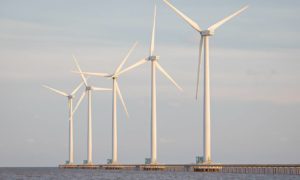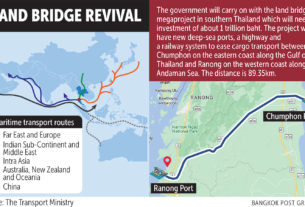
Investors pump billions into Vietnam’s offshore wind power plants
Foreign and local investors have poured billions of dollars into developing offshore wind farms.
Thang Long Wind, a $11.9-billion, 3.4 GW offshore plant, is being built in the central province of Binh Thuan.
Installation of floats will be completed in July to gather oceanographic data related to waves, wind and currents.
La Gan, another offshore wind farm, a joint venture between Asia Petroleum Energy Corporation (Asia Petro), Novasia Energy Company and Danish fund management firm Copenhagen Infrastructure Partners (CIP), will have a capacity of 3.5 GW and cost $10.5 billion.
Last month Danish multinational power company Orsted, which operates many wind farms in Asian countries, said it has identified Vietnam as its next investment destination.
It too is eyeing offshore wind power in Binh Thuan.
Vietnamese companies are investing heavily in offshore wind power. HBRE Group and a French partner have invested $1 billion in a 500-KW farm in the southern province of Ba Ria Vung Tau.
With a coastline of 3,260 km, low sea levels and high wind speeds (7-10 meters per second at a height of 100 meters), Vietnam is an emerging offshore wind power magnet in Southeast Asia.
Qiao Liming, Asia director of the Global Wind Energy Council (GWEC), said a strong point of offshore wind power is the high efficiency of 29-52 percent, double that of solar energy, higher than onshore wind power and equal to gas-fired electricity. With new technologies, the efficiency of offshore wind power is increasing annually by 2.5 percent, she said.
Despite great potential and opportunities, offshore wind power also poses some investment risks: The unit cost for offshore wind power is more than double that of onshore wind power, and it takes five to seven years to build a farm excluding the time needed for investment procedures, licenses, geological surveys, gauging winds, and others.
Construction is not easy and involves large costs.
A wind-power investor in the southern province of Soc Trang said: “The cost of offshore wind turbines is very high, at over $3 million on average for a 4.2-MW unit. Construction and installation are also costly due to the difficult terrain 30-50km from shore.
“Annual maintenance costs are high. For these reasons, only large investors can join this race.”
The unit cost for 1,000 kWh of electricity generated by an offshore wind power farm is around $83, down from $255 in 2010.
It is expected to further drop to $58 by 2025.
But Qiao said costs would decrease only when total installed capacity reaches a certain level, and Vietnam should quickly tap the opportunities to achieve this.
The draft of the Power Development Master Plan VIII defines offshore wind power farms as wind power plants to be built in areas where the sea is 20 meters deep or more.
The draft plan eyes offshore wind power capacity of 2-3 GW by 2030, or 1.5-2 percent of the country’s total.
Many international organizations have advised Vietnam to increase its offshore wind power capacity to 10 GW by 2030 to fully tap its potential.
Besides, they said only large-scale projects could attract investment.
To attract investors, Vietnam needs to have favorable mechanisms and policies for offshore wind power, including preferential prices.
The feed-in tariff (FIT) for offshore wind power currently stands at 9.8 cents per kilowatt-hour. The FIT for land-based wind power is 8.5 cents.
These are applicable to plants that begin commercial operation before November 1, 2021, and for a period of 20 years.
From November 1 the price mechanisms are set to change, with a spokesperson from the Electricity & Renewable Energy Authority saying the agency is creating a bidding mechanism for solar and wind power to replace FIT.
However, some energy investors feared this change would make it difficult for them.
Bernard Casey, development director at Mainstream Renewable Power Vietnam, expressed worries about the possible risks to his company’s $2-billion wind farm in the southern province of Soc Trang if the bidding mechanism takes effect.
Casey, Sebastian Hald Buhl, Vietnam Country Manager at Orsted, and Qiao Liming have said the government should have a roadmap for implementing the bidding mechanism.
FIT is a policy mechanism that offers cost-based compensation to renewable energy producers, providing price certainty and long-term contracts, which help attract finance.
Vietnam aims to produce 10.7 percent of its electricity from renewable energy sources by 2030, mainly through solar and wind power projects.
Source: https://e.vnexpress.net/news/business/industries/investors-pump-billions-into-offshore-wind-power-plants-4295106.html

